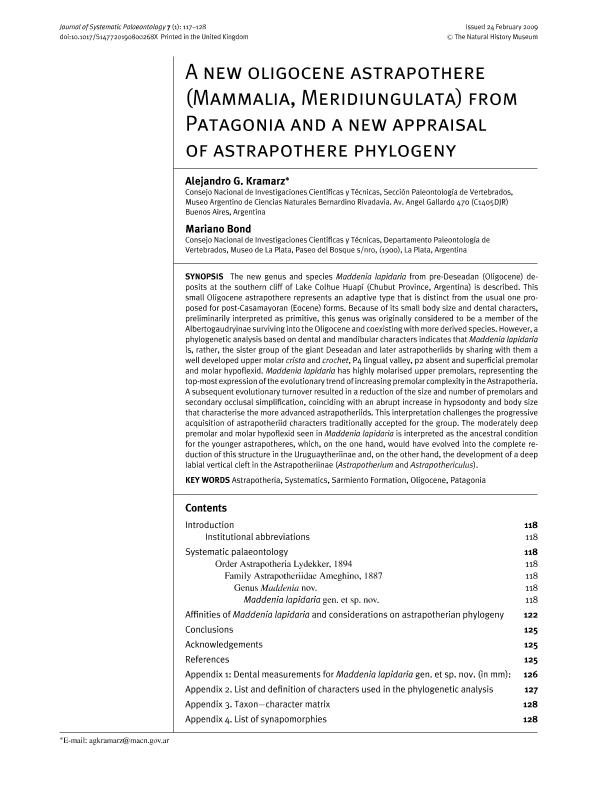Mostrar el registro sencillo del ítem
dc.contributor.author
Kramarz, Alejandro Gustavo

dc.contributor.author
Bond, Mariano

dc.date.available
2020-04-16T12:17:37Z
dc.date.issued
2009-03
dc.identifier.citation
Kramarz, Alejandro Gustavo; Bond, Mariano; A new oligocene astrapothere (Mammalia, Meridiungulata) from Patagonia and a new appraisal of astrapothere phylogeny; Cambridge University Press; Journal of Systematic Palaeontology; 7; 1; 3-2009; 117-128
dc.identifier.issn
1477-2019
dc.identifier.uri
http://hdl.handle.net/11336/102700
dc.description.abstract
A new oligocene astrapothere (Mammalia, Meridiungulata) from Patagonia and a new appraisalof astrapothere phylogenySYNOPSIS The new genus and species Maddenia lapidaria from pre-Deseadan (Oligocene) deposits at the southern cliff of Lake Colhue Huap´ý (Chubut Province, Argentina) is described. This small Oligocene astrapothere represents an adaptive type that is distinct from the usual one proposed for post-Casamayoran (Eocene) forms. Because of its small body size and dental characters, preliminarily interpreted as primitive, this genus was originally considered to be a member of the Albertogaudryinae surviving into the Oligocene and coexisting with more derived species. However, a phylogenetic analysis based on dental and mandibular characters indicates that Maddenia lapidaria is, rather, the sister group of the giant Deseadan and later astrapotheriids by sharing with them a well developed upper molar crista and crochet, P4 lingual valley, p2 absent and superficial premolar and molar hypoflexid. Maddenia lapidaria has highly molarised upper premolars, representing the top-most expression of the evolutionary trend of increasing premolar complexity in the Astrapotheria.A subsequent evolutionary turnover resulted in a reduction of the size and number of premolars and secondary occlusal simplification, coinciding with an abrupt increase in hypsodonty and body size that characterise the more advanced astrapotheriids. This interpretation challenges the progressive cquisition of astrapotheriid characters traditionally accepted for the group. The moderately deep premolar and molar hypoflexid seen in Maddenia lapidaria is interpreted as the ancestral condition for the younger astrapotheres, which, on the one hand, would have evolved into the complete reductionof this structure in the Uruguaytheriinae and, on the other hand, the development of a deeplabial vertical cleft in the Astrapotheriinae (Astrapotherium and Astrapothericulus).
dc.format
application/pdf
dc.language.iso
eng
dc.publisher
Cambridge University Press

dc.rights
info:eu-repo/semantics/openAccess
dc.rights.uri
https://creativecommons.org/licenses/by-nc-sa/2.5/ar/
dc.subject
ASTRAPOTHERIA
dc.subject
SYSTEMATICS
dc.subject
SARMIENTO FORMATION
dc.subject
OLIGOCENE
dc.subject
PATAGONIA
dc.subject.classification
Otras Ciencias de la Tierra y relacionadas con el Medio Ambiente

dc.subject.classification
Ciencias de la Tierra y relacionadas con el Medio Ambiente

dc.subject.classification
CIENCIAS NATURALES Y EXACTAS

dc.title
A new oligocene astrapothere (Mammalia, Meridiungulata) from Patagonia and a new appraisal of astrapothere phylogeny
dc.type
info:eu-repo/semantics/article
dc.type
info:ar-repo/semantics/artículo
dc.type
info:eu-repo/semantics/publishedVersion
dc.date.updated
2020-04-08T18:10:19Z
dc.journal.volume
7
dc.journal.number
1
dc.journal.pagination
117-128
dc.journal.pais
Reino Unido

dc.journal.ciudad
Cambridge
dc.description.fil
Fil: Kramarz, Alejandro Gustavo. Consejo Nacional de Investigaciones Científicas y Técnicas. Oficina de Coordinación Administrativa Parque Centenario. Museo Argentino de Ciencias Naturales "Bernardino Rivadavia"; Argentina
dc.description.fil
Fil: Bond, Mariano. Consejo Nacional de Investigaciones Científicas y Técnicas. Centro Científico Tecnológico Conicet - La Plata; Argentina. Universidad Nacional de La Plata. Facultad de Ciencias Naturales y Museo. División Paleontología Vertebrados; Argentina
dc.journal.title
Journal of Systematic Palaeontology

dc.relation.alternativeid
info:eu-repo/semantics/altIdentifier/doi/http://dx.doi.org/10.1017/S147720190800268X
dc.relation.alternativeid
info:eu-repo/semantics/altIdentifier/url/https://www.tandfonline.com/doi/abs/10.1017/S147720190800268X
Archivos asociados
